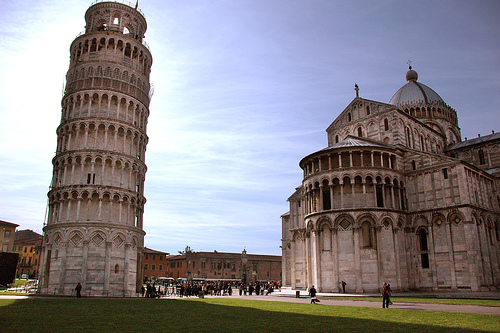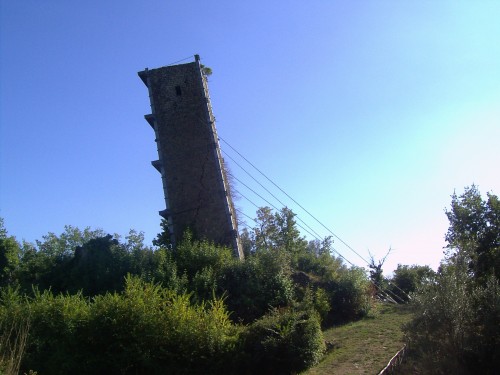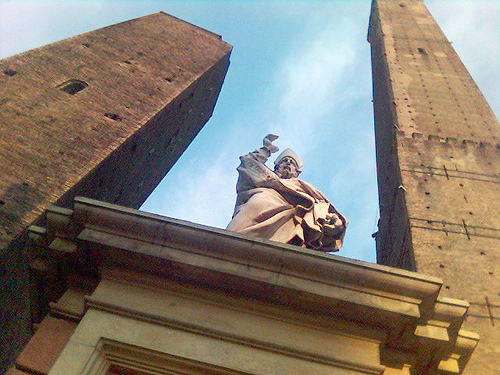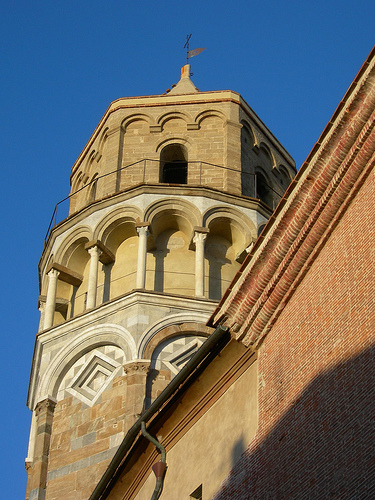Perhaps the most famous iconic structure in Italy is the leaning tower of Pisa. The tower is usually a staple tourist destination and people often will plan their vacations just so they can make a trip to Pisa for a glimpse of it. Yet many will be pleased to hear that there are other leaning towers throughout Italy—the tower in Pisa is not the only one!
The Tower of Pisa
Even though almost everyone has heard of this famous tower, not everyone knows the story behind it. The people of Pisa began building the tower in 1173 as a luxurious bell tower, solely to represent the wealth of the city. Once its third storey was constructed, however, people had to stop working because it was sinking into the ground (which is actually the reason why it leans). For the next 90 years, the tower remained untouched until it was finally completed in the 14th century. Today, people can walk up its interior spiral staircase of 294 steps, or even just appreciate the beautiful Romanesque architecture from the outside. If you go to the tower of Pisa, you’ll definitely need a few pictures!
The Tower of Vernazzano
This tower is located in the region of Umbria and Lake Trasimeno. I actually mentioned it once before in my article about lakes in Italy. The tower of Vernazzano stands in the upper part of the village. It is what remains of a castle, which due to erosion and landslides was abandoned by the Italian people. Then a 1753 earthquake caused the lean that you can go and see today. Its incline, come to find out, is greater than that of Pisa. Because of this, the tower is held stable by cables, and so tourists can only see it from the outside, as they cannot walk up to its top floor. This surely does not detract from its beauty, however, and many people hike up to the leaning tower of Vernazzano just to admire its aesthetics.
Torre delle Milizie (Tower of the Milices)
Also known as ‘Nero’s Tower’ because it is said that the Emperor Nero watched the fire of Rome from the top (though not proven yet), Torre delle Milizie stands with a slight lean in Rome. It is attached to the Imperial Fora’s Trajan’s Market. This 50 meter square tower leans because of an earthquake in 1348, which also caused the upper floor to crumble. The structure itself, though, dates back to around 1198. And it allegedly continues to lean further as time goes on.
The Asinelli and Garisenda Towers in Bologna
Bologna has quite a few towers, and so because of this larger population, it makes sense that a couple of them have become leaning towers. Both the Asinelli and Garisenda are known by one name as “The Two Towers.” The Asinelli is taller, while the Garisenda leans further. Both were constructed around 1109 and 1119, though no one knows for sure due to lack of documentation. The Asinelli began leaning because of being struck multiple times by lightning, which damaged it by causing small fires and collapses in the tower. The Garisenda, on the other hand, was actually lowered in height in the 14th century because of a change in stress on the ground which left the tower at a dangerous slant. It was originally only 10 meters lower than the Asinelli. Now it stands at 48 meters. Both towers act as important symbols of the city of Bologna.
Campanile of San Nicola
The Campanile of San Nicola, or bell tower of Saint Nicholas, is right next to the famous Saint Nicholas Church in Pisa. It is actually the second most famous bell tower in the city after the Leaning Tower of Pisa. The Campanile of San Nicola, octagonal in its shape, tilts slightly because it is buried under the surface of the road. The structure is decorated exquisitely with sandstone, marble columns, granite, and grey limestone throughout. On the inside, is an elegant spiral staircase which utilizes some of these materials as well in order to create a beautiful unity in the tower. In fact, it was actually constructed with the intention of referring to the Tower of Babel.
Have you ever visited one of these towers? Why not tell us about it in the comments?
Written by : Stephanie Photo Credits : McPig / WikimediaCommons / Chingers7 / Tristam Sparks / GiovanniV





